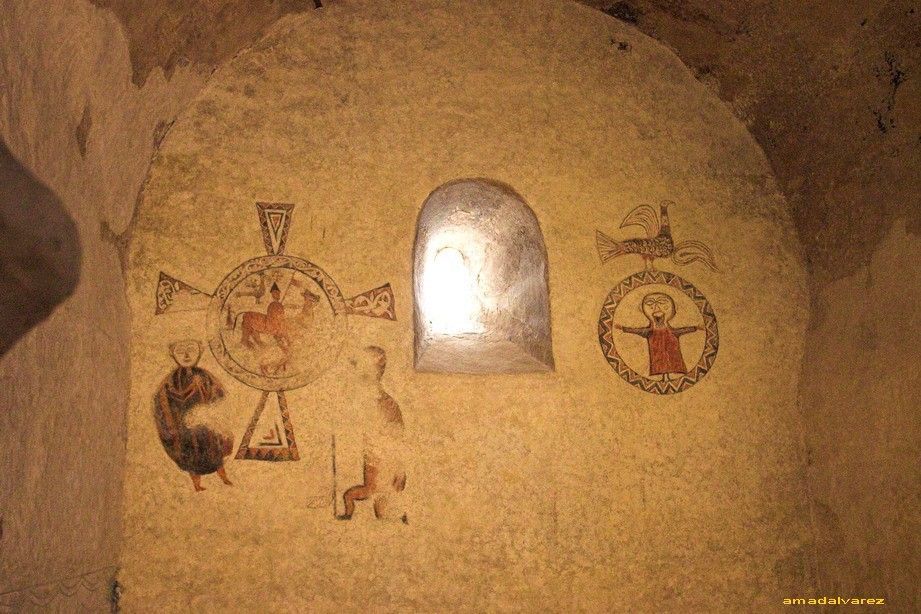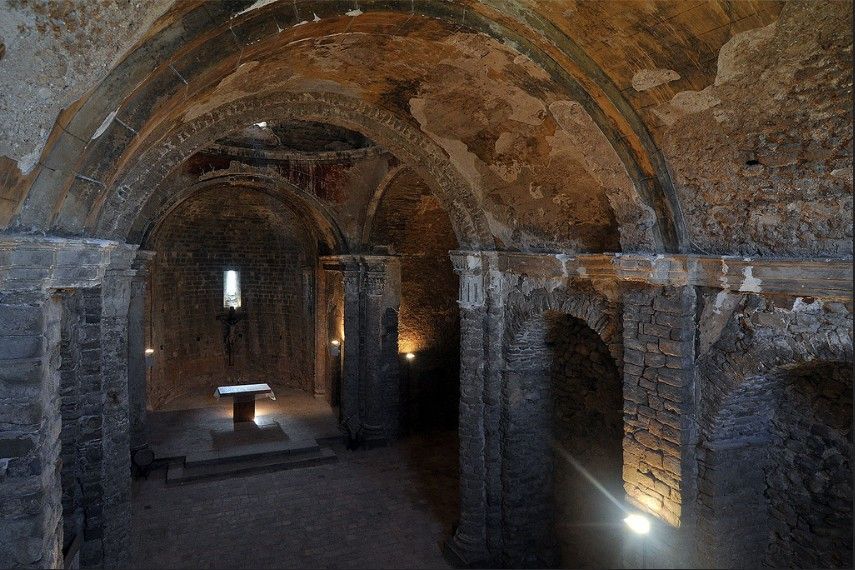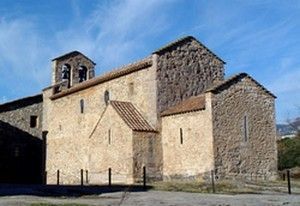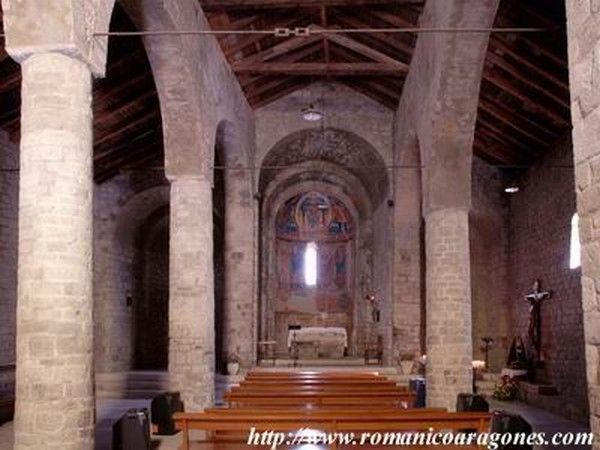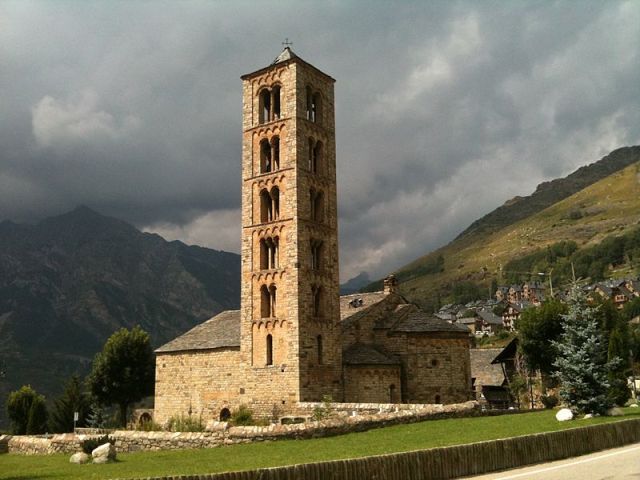MONASTERIO DE SANTA SERNI DE TAVÈRNOLES

Historic environment
The monastery of Sant Serni de Tavèrnoles was located just four kilometers north of La Seu d’Urgell, right at the entrance to the narrow Valira valley that would take us to Andorra, within the current municipality of Valls from Valira.
Regarding the origins of this house, it should be noted that the important work of interpolation and falsification of documents that was carried out in its scriptorium during the 10th and 11th centuries makes it very difficult for us to approach them, until the point that the first five documents that refer to it must be considered false. This implies that we do not find it referenced in any authentic writing until the year 835 and that, consequently, it does not  the old hypothesis can be tested that the famous bishop Feliu of Urgell, deposed towards In 799, under the accusation of adoptionist, he had also been abbot of that monastery. Likewise, it prevents us from confirming that Sant Serni really had continuity between the Visigothic and Carolingian periods. Therefore, without ruling out the possibility, it is to be hoped that archeology can provide new data that confirms the supposed, and so often proclaimed, Visigothic origin of this monastery.
the old hypothesis can be tested that the famous bishop Feliu of Urgell, deposed towards In 799, under the accusation of adoptionist, he had also been abbot of that monastery. Likewise, it prevents us from confirming that Sant Serni really had continuity between the Visigothic and Carolingian periods. Therefore, without ruling out the possibility, it is to be hoped that archeology can provide new data that confirms the supposed, and so often proclaimed, Visigothic origin of this monastery.
Be that as it may, there is no doubt that the arrival of Carolingian power meant profound changes for the monastery, since it is completely unthinkable that the coming of Benedict of Aniana in person to Urgell did not mean at least his complete Benedictinization; even more so if we take into account that its first abbot could have been the future bishop Possedoni, of Frankish descent. However, the evidence is scarce and, after 835 and a donation made to it by Bishop Sisebut of Urgell in 840, we do not find any other authentic document that refers to Sant Serni until the year 914. This brings us to a context very different historical period in which the monastery worked to enlarge its territorial domain and gain political significance alongside the new political powers, especially the counts of Urgell, who in the time of Borrell II emerged as its great supporters. Let us not forget, in this sense, the multiple wishes that this count made him, a practice that his descendants repeated throughout the following century.
Under the patronage of the counts of Urgell, the monastery of Sant Serni experienced its most splendid years, which led to the construction of a new monastic building in Romanesque style. However, from the end of the 12th century, the first symptoms of crisis began and, finally, it was secularized in 1592.
Description
Of the old monastery of Sant Serni de Tavèrnoles, only the apse and transept of the church that was built in the mid-11th century in Romanesque style remain standing, which were deeply restored at the end of the  20th century to be able to open to worship again. This fact completely blurs the whole, although it still reveals its enormous proportions. Likewise, it allows us to perceive its curious basilica plan with three naves, a transept topped by two apsidioles at its ends, and a large trilobular central apses. Finally, it should be noted that several sculptural and pictorial elements of the Romanesque complex have been preserved, among which two stuccos from the 11th century preserved in situ, ten capitals from the end of the 13th century kept in the National Museum. from Catalonia and, in the same institution and from the same chronology, a fragment of a polychrome canopy and an altar frontal. Therefore, despite its precarious state of conservation, it is one of the most important Romanesque monasteries in Catalonia.
20th century to be able to open to worship again. This fact completely blurs the whole, although it still reveals its enormous proportions. Likewise, it allows us to perceive its curious basilica plan with three naves, a transept topped by two apsidioles at its ends, and a large trilobular central apses. Finally, it should be noted that several sculptural and pictorial elements of the Romanesque complex have been preserved, among which two stuccos from the 11th century preserved in situ, ten capitals from the end of the 13th century kept in the National Museum. from Catalonia and, in the same institution and from the same chronology, a fragment of a polychrome canopy and an altar frontal. Therefore, despite its precarious state of conservation, it is one of the most important Romanesque monasteries in Catalonia.
As regards the monastic complex from the 9th-10th century, to this day, no material remains are known. It is hoped that, in the future, archeology can provide more information in this regard.
Xavier Costa Badía for URBS REGIA
Other interesting information
Visiting hours:: Arranged visits
Bibliography
Ramon d’Abadal, La batalla del Adopcionismo en la desintegración de la Iglesia visigoda. Discruso de recepción (Barcelona: Real Academia de Buenas Letras de Barcelona, 1949), p. 160-62.
Cebrià Baraut, «Diplomatari del monestir de Sant Sadurní de Tavèrnoles (segles IX-XIII)», Urgellia, 12 (1995), 7-414.
Cebrià Baraut, «El monestir de Sant Sadurní de Tavèrnoles i els orígens del monaquisme benedictí al comtat d’Urgell», Studia monastica, 22.2 (1980), 253-59.
Cebrià Baraut, «La intervenció carolíngia antifeliciana al bisbat d’Urgell i les seves conseqüències religioses i culturals (segles VIII-IX)», a Jornades Internacionals d’Estudi sobre el bisbe Feliu d’Urgell. La Seu d’Urgell, 28-30 de setembre de 1999. Crònica i estudis, ed. Josep Perarnau (Coord.) (La Seu d’Urgell: Facultat de Teologia de Catalunya; Societat Cultural Urgel·litana, 2000), p. 155-93.
Maria Rosa Cerdá Gasch, «Génesis y desarrollo del dominio territorial del monasterio de Sant Sadurní de Tavernoles en los siglos IX, X y XI», a Actas del VII Congreso Internacional de Estudios Pirenaicos (Jaca: Institut de Estudios Pirenaicos-CSIC, 1983), p. 69-77.
Xavier Costa Badia, Paisatges monàstics. El monacat alt-medieval als comtats catalans (segles IX-X) (Barcelona: Tesi doctoral inèdita dipositada a la Universitat de Barcelona, 2019), p. 226-8.
Josep M. Nogués Torre, Els benedictins a Tavèrnoles-Anserall (Lleida: Pagès editors, 2011)
Manuel Riu, «Revisión del problema adopcionista en la diòcesis de Urgel», Anuario de Estudios Medievales, 1 (1964), 77-96.
Portals

















